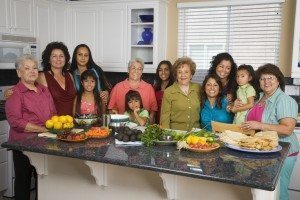Understanding Cousins: Extended Family and Genealogy Research

Understanding cousins and extended family relationships can be one of the more archaic aspects of genealogical research. When your explorations move beyond your direct ancestors to encompass what their siblings or other children might have done, you invariably find someone who has lived a fascinating life. Then you start trying to puzzle out how you’re related. You’ve probably heard the term “third cousin, five times removed” used in at least one Downton Abbey episode. But what does that really mean?
The basics of cousin relationships
When you first think of your cousins, you probably think of the children of your mother’s or father’s siblings. These first cousins are a great illustration of cousin principles. Cousins have a common ancestor, and the level of “cousinhood” is determined by how many generations back the common ancestor was. For example, first cousins share two common grandparents, second cousins a common great-grandparent, third cousins share a great-great-grandparent, and so forth.
Understanding “removes”
A cousin will be “removed” if there is a difference in the number of generations between them and the shared ancestor. Consider two people who are first cousins, John and Jared. If John has a child, Becky, then that child becomes a first cousin once removed from Jared. This is because John and Jared share a common grandparent. But Jared’s and Becky’s relationship to the common ancestor is different, namely it’s Jared’s grandparent and Becky’s great-grandparent. If Jared also has a child, then that child and Becky would be second cousins. To simplify things, the term “removed” can typically be interpreted to mean generational differences. Two levels of generational differences would be described as “twice removed” and so forth.
Determining cousinhood without getting confused
There are a number of reasons that people want to understand cousinhood. In many cases, it’s simply to help make sense of genealogical information. In other cases, it’s for presentations or even for use in heir research cases. The simplest way to definitively determine the relationship between two people is to create a comprehensive family tree. Start with your shared ancestor and then map out each generation until the people represented are listed. Now, count back the generations for each person to the shared ancestor. Note those numbers and compare. Are you the same generation or is there a mismatch? This information will determine both degree of cousinhood and if there are removals. If you’re struggling to visually quantify the relationships, a family relationship chart in the form of a tale can be helpful to map out
If you still have questions, this family relationships chart from Family History Magazine is a helpful reference material to have on hand when exploring this issue. Do you need assistance navigating a specific genealogical research question? Contact us today to discuss your specific research needs and how the Price and Associates team can help. Our services range from full-scale research projects to brief consultations to answer questions and help researchers understand everything from using genealogical databases to understanding cousin relationships.
